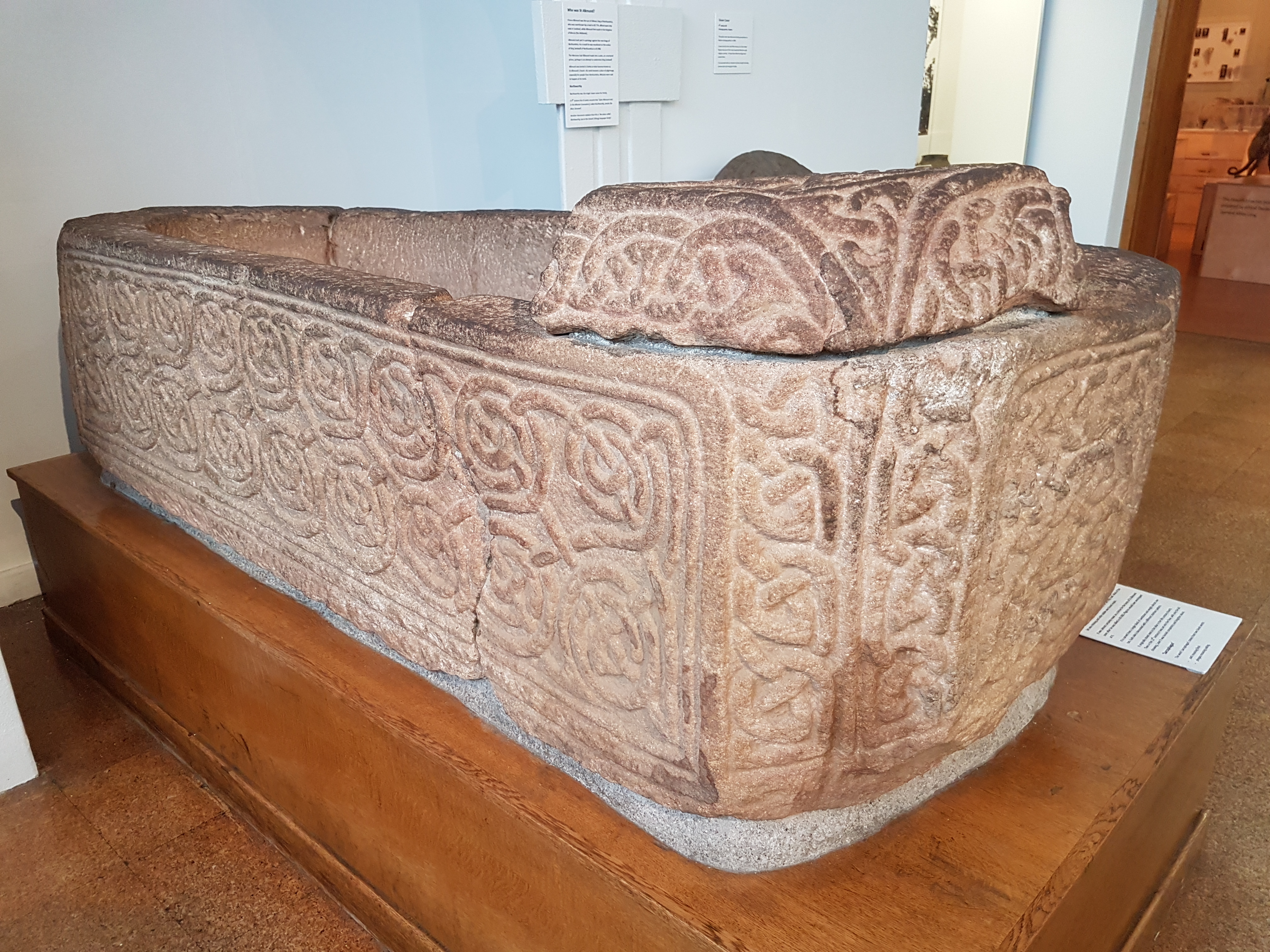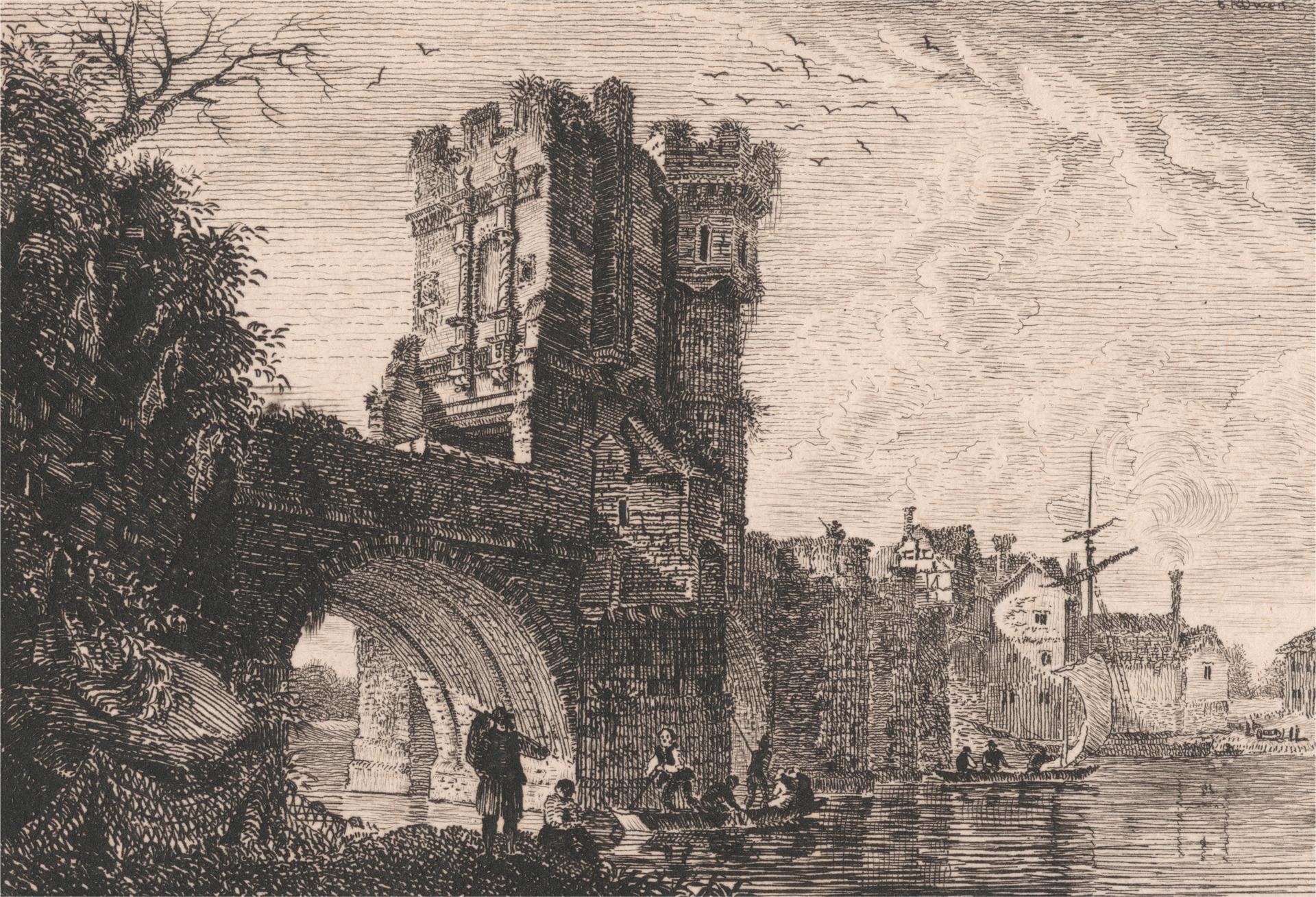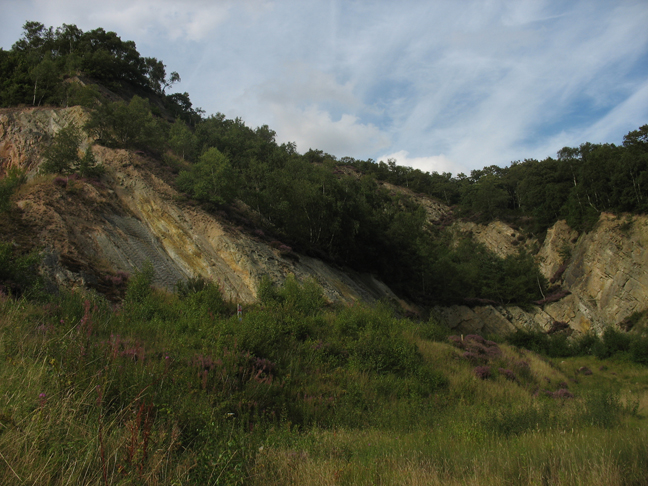|
Mountfields
Mountfields is an area in Shrewsbury, England, just north of the Welsh Bridge. History Historically famous for pubs and brothels frequented by barge pullers after being paid on Frankwell Quay, Mountfields is now better known as the location of Shrewsbury's Theatre Severn. Mountfields forms part of the Frankwell area and has a rich history, much of which relates to the original Welsh Bridge (a.k.a. St George's Bridge) which crossed the Severn opposite the medieval street 'Mardol' 70m upstream from the current bridge. The quayside, from which a shanty-type industrial area known as 'Frankwell Forge' was forcefully cleared in 2004, still houses 'The Stew', a derelict building named after a nearby brothel that is the area's only remaining link with the town's history as a river port. The Stew has notoriously been trapped in planning controversies regarding renovation since 2004. Darwin Trail The Darwin Trail passes through Mountfields, following the River Severn along the track u ... [...More Info...] [...Related Items...] OR: [Wikipedia] [Google] [Baidu] |
Shrewsbury
Shrewsbury ( , ) is a market town and civil parish in Shropshire (district), Shropshire, England. It is sited on the River Severn, northwest of Wolverhampton, west of Telford, southeast of Wrexham and north of Hereford. At the 2021 United Kingdom census, 2021 census, the parish had a population of 76,782. It is the county town of the ceremonial county of Shropshire. Shrewsbury has Anglo-Saxons, Anglo-Saxon roots and institutions whose foundations, dating from that time, represent a cultural continuity possibly going back as far as the 8th century. The centre has a largely undisturbed medieval street plan and over 660 Listed buildings in Shrewsbury, listed buildings, including several examples of timber framing from the 15th and 16th centuries. Shrewsbury Castle, a red sandstone fortification, and Shrewsbury Abbey, were founded in 1074 and 1083 respectively by the Normans, Norman Earl of Shrewsbury, Roger de Montgomery. The town is the birthplace of Charles Darwin. It has ... [...More Info...] [...Related Items...] OR: [Wikipedia] [Google] [Baidu] |
Frankwell
Frankwell is a district of the town of Shrewsbury, in Shropshire, England. It lies adjacent to the River Severn, to the northwest of the town centre, and is one of Shrewsbury's oldest suburbs. The main road running through the area is also called Frankwell. Frankwell grew up as a port and trading location by the river and on the road to Wales, but across the river from the walled borough of Shrewsbury and therefore beyond the town's jurisdiction. There have been a number of suggestions about where the name derives from, but one possible origin is "Frankville", which means a town of free trade. Being independent from the larger borough of Shrewsbury gave it a local nickname of the Little Borough, a name which is used to this day. Today Frankwell continues to be a commercial area of the town, lying just outside the town centre, with its own character and identity. There has been much redevelopment recently near to the river, especially now flood defences have been constructed, an ... [...More Info...] [...Related Items...] OR: [Wikipedia] [Google] [Baidu] |
The Mount, Shrewsbury
The Mount is the Georgian house in Shrewsbury, England where Charles Darwin was born. Overview The large Georgian house was built in 1800 by Charles Darwin's father, the successful local doctor Robert Darwin. His son Charles was born there on 12 February 1809. Robert Darwin died in the house on 13 November 1848, followed by his unmarried daughters Catherine and Susan. Since there were no surviving members of the Darwin family in residence, the house was then put up for auction, after the three surviving Darwin children, Ras, Charles, and Caroline Wedgwood had taken what possessions they wished. , the house is occupied by the District Valuer and Valuation Office of Shrewsbury, and visits may be made by appointment during office hours. The building is grade II* listed. The site is not recognized as a museum. However, Down House, in Bromley (London), where Darwin spent most of his adult life, is a museum. In January 2018, a steering group was established by the Mayor of Shr ... [...More Info...] [...Related Items...] OR: [Wikipedia] [Google] [Baidu] |
Welsh Bridge
The Welsh Bridge is a masonry arch viaduct in the town of Shrewsbury, England, which crosses the River Severn. It connects Frankwell with the town centre. It is a Grade II* listed building. The bridge is located north-west of Shrewsbury whereas its "sister bridge", the English Bridge, is located too the east of the town. The bridge was designed and built from 1793 to 1795 by John Tilley and John Carline (whose namesake father was a mason on the English Bridge), who had built Montford Bridge for Thomas Telford. It replaced the medieval St George's Bridge. Four of the arches span 43 feet 4 inches, while the fifth and central arch is 46 feet 2 inches, and there is a narrower towpath arch on north end. The bridge is 30 feet wide, and built from Grinshill sandstone. In total it is 266 feet long. It was completed in 1795 at a cost of £8,000. On the south end of the bridge, on the junction with Victoria Avenue, one of the parapets of the bridge has the words "Commit ... [...More Info...] [...Related Items...] OR: [Wikipedia] [Google] [Baidu] |
St George's Bridge
St George's Bridge was a bridge over the River Severn in Shrewsbury, England; so named as it was close to the medieval St George's Hospital. It connected Frankwell, an old suburb of the town, to the town centre via Mardol. The gate on the town side was called ''Mardol Gate'' and is located where the Mardol Quay Gardens are. The gate on the other side was called ''Welsh Gate'' or ''St George's Gate''. The bridge, sometimes now known as the Old Welsh Bridge, was demolished in 1795 and was replaced with the Welsh Bridge. History The bridge's date of construction is believed to have been about 1262. The bridge was variously described as ''Walshebrugge'' (in 1336), and ''Walshemanne's brigge'' (in 1351). A public convenience was built on it in about 1496. One span was a timber drawbridge, while several shops had been built near the middle of the bridge. It is recorded that one tower was still in existence until late in the bridge's life. Above the main tower was a statue of ... [...More Info...] [...Related Items...] OR: [Wikipedia] [Google] [Baidu] |
River Severn
The River Severn (, ), at long, is the longest river in Great Britain. It is also the river with the most voluminous flow of water by far in all of England and Wales, with an average flow rate of at Apperley, Gloucestershire. It rises in the Cambrian Mountains in mid Wales, at an altitude of , on the Plynlimon massif, which lies close to the Ceredigion/Powys border near Llanidloes. The river then flows through Shropshire, Worcestershire and Gloucestershire. The county towns of Shrewsbury, Worcester, England, Worcester and Gloucester lie on its course. The Severn's major tributaries are the River Vyrnwy, Vyrnwy, the River Tern, Tern, the River Teme, Teme, the Warwickshire Avon, and the River Stour, Worcestershire, Worcestershire Stour. By convention, the River Severn is usually considered to end, and the Severn Estuary to begin, after the Prince of Wales Bridge, between Severn Beach in South Gloucestershire and Sudbrook, Monmouthshire. The total area of the estuary's draina ... [...More Info...] [...Related Items...] OR: [Wikipedia] [Google] [Baidu] |
Charles Darwin
Charles Robert Darwin ( ; 12 February 1809 – 19 April 1882) was an English Natural history#Before 1900, naturalist, geologist, and biologist, widely known for his contributions to evolutionary biology. His proposition that all species of life have descended from a Common descent, common ancestor is now generally accepted and considered a fundamental scientific concept. In a joint presentation with Alfred Russel Wallace, he introduced his scientific theory that this Phylogenetics, branching pattern of evolution resulted from a process he called natural selection, in which the struggle for existence has a similar effect to the artificial selection involved in selective breeding.. Darwin has been described as one of the most influential figures in human history and was honoured by Burials and memorials in Westminster Abbey, burial in Westminster Abbey. Darwin's early interest in nature led him to neglect his medical education at the University of Edinburgh Medical Schoo ... [...More Info...] [...Related Items...] OR: [Wikipedia] [Google] [Baidu] |
Shrewsbury School
Shrewsbury School is a Public school (United Kingdom), public school in Shrewsbury. Founded in 1552 by Edward VI by royal charter, to replace the town's Saxon collegiate foundations which were disestablished in the sixteenth century, Shrewsbury School is one of the seven Public school (United Kingdom), public schools subject to the Public Schools Act 1868 and one of the nine schools reviewed by the Clarendon Commission between 1861 and 1864. It was originally founded as a boarding school for boys. In 2008, however, girls were accepted in the Sixth Form. And since 2015 Shrewsbury School has become a Mixed-sex education, co-educational school. As at Michaelmas Term 2023, Shrewsbury School had 842 pupils: 522 boys and 320 girls. The school has seven boys', and five girls' houses.Independent Schools Inspectora ... [...More Info...] [...Related Items...] OR: [Wikipedia] [Google] [Baidu] |
Robert Darwin
Robert Waring Darwin (30 May 1766 – 13 November 1848) was an English medical doctor who is today best known as the father of naturalist Charles Darwin. He was a member of the influential Darwin–Wedgwood family. Biography Darwin was born in Lichfield, the son of physician Erasmus Darwin and his first wife, Mary Howard. He was named after his uncle, Robert Waring Darwin of Elston (1724–1816), a bachelor. His mother died in 1770 and Mary Parker, the governess hired to look after him, became his father's mistress and bore Erasmus two illegitimate daughters. In 1783, Darwin began his studies of medicine at the University of Edinburgh, where he apparently took lodgings with the chemistry professor Joseph Black. His father then sent him to the Leiden University in the Netherlands for a few months, and he took his MD there on 26 February 1785. His Leyden dissertation was impressive and was published in the ''Philosophical Transactions'', but his father may have assisted him ... [...More Info...] [...Related Items...] OR: [Wikipedia] [Google] [Baidu] |
Susannah Darwin
Susannah Darwin (née Wedgwood, 3 January 1765 – 15 July 1817) was the wife of Robert Darwin, a wealthy doctor, and mother of naturalist Charles Darwin, and part of the Wedgwood pottery family. Biography Early life Susannah Wedgwood was the daughter of Josiah Wedgwood, Josiah and Sarah Wedgwood and grew up at Etruria Hall, the Wedgwood family home in Stoke on Trent (completed in 1771). Josiah Wedgwood's business was already successful and expanding when she was born, and she grew up in increasingly comfortable circumstances. She was the oldest of the Wedgwood's eight children, known as "Sukey" within the family. Her baptism in January 1765, at home because of bad weather, was followed by a lobster dinner, with Port wine, port, for the family, though as a sign of things to come, her father had to leave early to deal with business matters. At the age of seven, she was sent to a boarding school in Manchester but returned home for the summer holidays "full of pouks, & boils & ... [...More Info...] [...Related Items...] OR: [Wikipedia] [Google] [Baidu] |
HM Prison Shrewsbury
HM Prison Shrewsbury was a category B/C men's prison in Shrewsbury, Shropshire, England. It was decommissioned in March 2013, and is now open to the public. The Victorian prison as seen today sits on top of the original Georgian prison, the remains of which are still accessible underneath the current buildings. The former prison site, on Howard Street, adjacent to Shrewsbury railway station, is near the site of the Dana Gaol, a medieval prison. The name The Dana is still often used for the prison, as well as being the name of the road to one side of the prison and the pedestrian route that runs from near the front of the prison into the town centre via a footbridge over the station. Shrewsbury Prison is now open to the public as an interactive tourism destination, The Campbell Group runs guided tours, ghost tours and various activities throughout the 4 acre-site. The prison will continue to operate as a tourism destination and there are now no plans for re-development. Histo ... [...More Info...] [...Related Items...] OR: [Wikipedia] [Google] [Baidu] |
Shropshire Wildlife Trust
The Shropshire Wildlife Trust (SWT) is a wildlife trust covering the geographic county of Shropshire, England. Nature reserves The trust manages 42 nature reserves (plus its headquarters in Shrewsbury – see next section) in the county: Headquarters The Trust has its main offices and visitor centre at 193 Abbey Foregate near the centre of Shrewsbury – they occupy the former "Shrewsbury Quest" museum, on the corner of Abbey Foregate and Old Potts Way, opposite The Abbey church. The site encompasses a restored medieval building known as the Old Infirmary and a 1730s building called Queen Anne House, as well as gardens, including a herb garden established when the site was the Shrewsbury Quest, and a fruit tree garden. The centre and its gardens is open to the public (usually Monday – Saturday) and has a shop as well as conference rooms available for hire. Many Trust-run events take place here, including children's events during the summer holidays. Every year the cent ... [...More Info...] [...Related Items...] OR: [Wikipedia] [Google] [Baidu] |







